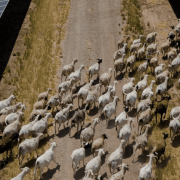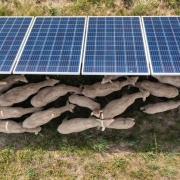At the Azure Sky solar and storage project in Haskell County, Tex., 700,000 photovoltaic panels stretch in uniform rows across the desert landscape, shimmering under a relentless summer sun. Beneath the panels, hundreds of Dorper sheep graze on Bermuda and Johnson grasses, driven there by two border collies named Bucky and Johnny.
The sheep belong to Chad Raines, owner of Key Farms in Lamesa, Tex., and they are part of a new initiative called solar grazing. In addition to providing a low cost, eco-friendly mowing service to energy companies, Raines manages a solar site that provides an estimated 586 gigawatts annually to the booming Texas solar industry.
“We still farm and do everything we used to,” said Raines, “except underneath solar panels.”
Click here to read the full article
Source: The Washington Post
—
If you have any questions or thoughts about the topic, feel free to contact us here or leave a comment below.


